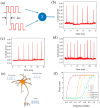Starch-Glycerol-Based Hydrogel Memristors for Bio-Inspired Auditory Neuron Applications
- PMID: 40558722
- PMCID: PMC12192081
- DOI: 10.3390/gels11060423
Starch-Glycerol-Based Hydrogel Memristors for Bio-Inspired Auditory Neuron Applications
Abstract
In the era of artificial intelligence, the demand for rapid and efficient data processing is growing, and traditional computing architectures are increasingly struggling to meet these needs. Against this backdrop, memristor devices, capable of mimicking the computational functions of brain neural networks, have emerged as key components in neuromorphic systems. Despite this, memristors still face many challenges in biomimetic functionality and circuit integration. In this context, a starch-glycerol-based hydrogel memristor was developed using starch as the dielectric material. The starch-glycerol-water mixture employed in this study has been widely recognized in literature as a physically cross-linked hydrogel system with a three-dimensional network, and both high water content and mechanical flexibility. This memristor demonstrates a high current switching ratio and stable threshold voltage, showing great potential in mimicking the activity of biological neurons. The device possesses the functionality of auditory neurons, not only achieving artificial spiking neuron discharge but also accomplishing the spatiotemporal summation of input information. In addition, we demonstrate the application capabilities of this artificial auditory neuron in gain modulation and in the synchronization detection of sound signals, further highlighting its potential in neuromorphic engineering applications. These results suggest that starch-based hydrogel memristors offer a promising platform for the construction of bio-inspired auditory neuron circuits and flexible neuromorphic systems.
Keywords: artificial auditory neuron; gain modulation; hydrogel; memristor; spatiotemporal integration; starch–glycerol; synchronization detection.
Conflict of interest statement
The authors declare that they have no known competing financial interests or personal relationships that could have appeared to influence the work reported in this paper.
Figures






Similar articles
-
Memristor-Based Artificial Neural Networks for Hardware Neuromorphic Computing.Research (Wash D C). 2025 Jul 4;8:0758. doi: 10.34133/research.0758. eCollection 2025. Research (Wash D C). 2025. PMID: 40625658 Free PMC article. Review.
-
Signs and symptoms to determine if a patient presenting in primary care or hospital outpatient settings has COVID-19.Cochrane Database Syst Rev. 2022 May 20;5(5):CD013665. doi: 10.1002/14651858.CD013665.pub3. Cochrane Database Syst Rev. 2022. PMID: 35593186 Free PMC article.
-
Systemic pharmacological treatments for chronic plaque psoriasis: a network meta-analysis.Cochrane Database Syst Rev. 2021 Apr 19;4(4):CD011535. doi: 10.1002/14651858.CD011535.pub4. Cochrane Database Syst Rev. 2021. Update in: Cochrane Database Syst Rev. 2022 May 23;5:CD011535. doi: 10.1002/14651858.CD011535.pub5. PMID: 33871055 Free PMC article. Updated.
-
Enhancing in-situ updates of quantized memristor neural networks: a Siamese network learning approach.Cogn Neurodyn. 2024 Aug;18(4):2047-2059. doi: 10.1007/s11571-024-10069-1. Epub 2024 Feb 13. Cogn Neurodyn. 2024. PMID: 39534792 Free PMC article.
-
Antidepressants for pain management in adults with chronic pain: a network meta-analysis.Health Technol Assess. 2024 Oct;28(62):1-155. doi: 10.3310/MKRT2948. Health Technol Assess. 2024. PMID: 39367772 Free PMC article.
References
-
- Wang W., Danial L., Li Y., Herbelin E., Pikhay E., Roizin Y., Hoffer B., Wang Z., Kvatinsky S. A memristive deep belief neural network based on silicon synapses. Nat. Electron. 2022;5:870–880. doi: 10.1038/s41928-022-00878-9. - DOI
Grants and funding
LinkOut - more resources
Full Text Sources

